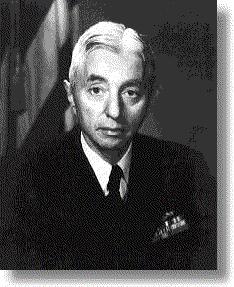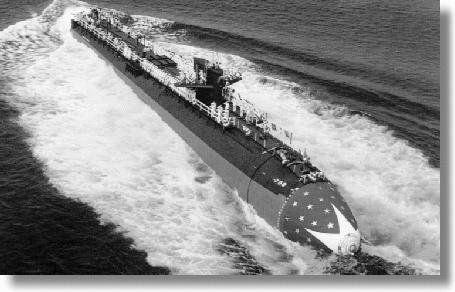WASHINGTON (NWSA) -- The Navy celebrated the 50th anniversary of nuclear power at a ceremony at the Navy Memorial in Washington Aug. 30.
CAPT Hyman G. Rickover started the Nuclear Power Branch in August 1948, with the responsibility of conducting research related to the application of nuclear power to Navy warships. In less than six years, Rickover and his team of Navy, government and contractor engineers created a revolution in warfare. They developed an industrial base, pioneered new materials, designed, built and operated a prototype reactor, established a training program, trained and qualified a Navy crew and took the world's first nuclear- powered submarine to sea. The success and speed of this development has given America undersea and nuclear propulsion superiority ever since.
In the years since USS Nautilus radioed its historic message, "Underway on nuclear power," U.S. nuclear-powered warships have steamed over 114 million miles around the globe, protecting democracy and maintaining freedom of the seas. These ships are welcomed in more than 150 ports in more than 50 foreign countries and dependencies. Today, this program is responsible for more than 116 nuclear reactors aboard 95 submarines and aircraft carriers.
The accomplishments of Naval Reactors are a testament to the insight and dedication of Rickover and his successors, as well as the many thousands of engineers, Sailors, shipyard workers, contractors and others who continue to uphold the tradition of excellence established in the program's early years.
"This organization went a long way in winning the Cold War," said ADM Frank (Skip) Bowman, Director of Naval Nuclear Propulsion. "I think that that's an important legacy for people to recognize - that high standards of excellence lead to victory."
Among the program's greatest achievements is the fact that through 50 years and so many millions of miles steamed in carrying out its mission, there has never been a reactor accident or any release of radioactivity which has had a significant effect on the environment.
Secretary of the Navy John H. Dalton said, "I think it's a legacy of safety, professionalism, of design, of planning, of vision, and commitment. I think the Naval Reactors Program indeed, exemplifies our CORE values of Honor Courage and Commitment."
"Naval Reactors Program is always advancing technologically," said former Chief of Naval Operations and former Secretary of Energy ADM James Watkins, Ret. "They are now putting in nuclear cores that will last for the lifetime of a ship. That was unheard of in my day."
"It is with great pride that I offer my congratulations on the 50th anniversary of the Naval Nuclear Propulsion Program. This historic occasion reflects an unequaled record of professional excellence and technological breakthroughs.
In early 1955, the world's first nuclear-powered submarine, USS Nautilus, put to sea. A mere five years later, USS Triton followed the route of Ferdinand Magellan to become the first warship to circumnavigate the globe while submerged. That same year, USS George Washington, our first fleet ballistic missile submarine, fired the first Polaris missile while submerged. This amazing enhancement to our national defense was quickly followed by the world's first nuclear-powered aircraft carrier, USS Enterprise, guaranteeing America's dominance at sea.
These early successes led to the fleet of nuclear- powered aircraft carriers, cruisers and submarines that proved so vital to achieving victory in the Cold War and maintaining the peace today. As we look to the future, nuclear-powered warships will continue to protect our nation by offering vital options for preserving the peace, responding to crises, and prevailing in war.
Nuclear propulsion provides our aircraft carriers with virtually unlimited range and endurance at high speeds, allows carrying substantially greater amounts of munitions and aircraft fuel, and dramatically reduces dependence on logistical support. These advantages result in increased operational flexibility, independence and survivability.
Nuclear power also arms our submarines with the stealth and mobility needed to survive in the most lethal battlespace. Whether operating independently or in concert with aircraft carrier battle groups, nuclear-powered submarines are critical to achieving forward presence, sea superiority and strategic deterrence.
The remarkable contribution of nuclear-powered warships to our national security results from the commitment and hard work of thousands of individuals - military and civilian - who have served and are serving in the Nuclear Propulsion Program. I salute these patriots and mariners as we commemorate this landmark event. Well Done!"
ADM Jay. L Johnson
Admiral Hyman G. Rickover | |
Father of the Nuclear Navy | |
 ADM H.G. Rickover, 1900-1986 |
Born in Russian occupied Poland in 1900, coming to America
at the age of 6 and growing up in the ghettos of Chicago contributed to
the abrasiveness and disregard of regulations that became the trademark
of this Admiral.
Setting an unprecedented 63 years of naval service, Admiral Rickover's career started in 1918 and spanned two world wars, finally retiring in 1982... 20 years past the governments mandatory retirement age. Graduating from the Naval Academy in 1922, he served on battleships and submarines over the next 15 years. In 1937, he was given command of the minesweeper Finch, assigned to the Asiatic Fleet. |
| Later in 1937, he was selected as an Engineering Duty Officer and transferred
to the Navy Yard in Cavite, Philippine Islands. In 1939, he was transferred
to the Bureau of Ships (BUSHIPS) in Washington D.C. where he spent most
of World War II. While serving as Head of the Electrical Section, he was
awarded the Legion of Merit for "exceptionally meritorious conduct".
Later assigned to the Manhattan Project, he received a Letter of Commendation for "outstanding service in connection with the development of the atomic bomb" while serving as the Assistant Director of Operations. He finished the war completing other duties as Commander Service Force Pacific Fleet staff member, Industrial Manager and Commander Naval Repair Base Okinawa. Several months after the war, he was assigned as Inspector General of the US 19th Fleet, engaged in the mothballing of Pacific Fleet ships. His career with nuclear propulsion began in 1947 when he was assigned again to BUSHIPS, this time in the nuclear propulsion department and then to the division of Reactor Development of the US Atomic Energy Commission (AEC).
Over his career, Admiral Rickover received 13 military medals, including three Distinguished Service Medals (highest peacetime award), 61 civilian awards (including the prestigious Enrico Fermi Award) and 15 honorary degrees. Additionally, he is the only person in recent history to have received TWO Congressional Gold Medals for his achievements. On July 8, 1986, Admiral Rickover quietly passed away at his Arlington, Virginia home. However, his presence in the Nuclear Navy will be felt for years to come. |
|

This page hosted by
Get your own FREE home page.